Foundation Bolts vs. Other Anchoring Methods: a Comparative Analysis
Prontofabril

Introduction:
In construction and engineering projects, the stability and safety of structures are of paramount importance. Anchoring methods play a crucial role in ensuring the integrity of a building's foundation. Among the various anchoring techniques available, foundation bolts have emerged as a popular choice. In this comparative analysis, we will explore the benefits and drawbacks of foundation bolts in comparison to other common anchoring methods.
Foundation Bolts:
Foundation bolts are threaded rods or bars that are embedded into concrete or masonry structures to secure and stabilize various components, such as columns, beams, walls, and machinery. These bolts are typically made of steel and are anchored deep into the foundation, ensuring a strong connection. Foundation bolts offer several advantages:
Strength and Stability: Foundation bolts provide excellent load-bearing capacity, making them suitable for heavy structures. They offer exceptional stability and resist lateral forces, ensuring the structure remains secure and intact.
Flexibility: Foundation bolts can be customized to meet specific project requirements. They are available in various lengths, diameters, and thread configurations, allowing for versatility in anchoring different types of equipment and structures.
Easy Installation: Foundation bolts are relatively easy to install, requiring minimal specialized equipment. Once the concrete foundation is prepared, the bolts are embedded, and the nuts are tightened, providing a secure connection within the structure.
Adjustable: Foundation bolts can be adjusted or repositioned during installation if needed. This flexibility is particularly useful when aligning columns or beams accurately.
Other Anchoring Methods:
While foundation bolts have numerous advantages, it is important to consider alternative anchoring methods for specific project requirements. Let's explore a few other commonly used techniques and their characteristics:
Anchor Plates: Anchor plates are metal plates with holes for bolts or rods. They distribute the load over a larger surface area, enhancing stability. However, anchor plates may require more space and can be less visually appealing compared to foundation bolts.
Chemical Anchors: Chemical anchors involve using resin or adhesive to secure bolts into the foundation. This method offers excellent load capacity and is suitable for applications where drilling is not possible. However, chemical anchors can be expensive and may require specialized expertise for installation.
Expansion Anchors: Expansion anchors consist of bolts with an expandable sleeve or plug. As the bolt is tightened, the sleeve expands, providing a secure grip within the concrete. While expansion anchors are easy to install and can be removed if necessary, they may not offer the same level of load-bearing capacity as foundation bolts.
Comparative Analysis:
When comparing foundation bolts to other anchoring methods, several factors should be considered, including load capacity, installation ease, flexibility, and cost. Foundation bolts often outshine other techniques due to their superior load-bearing capacity, ease of installation, adjustability, and cost-effectiveness. However, specific project requirements, space limitations, and aesthetic considerations may favor alternative anchoring methods such as anchor plates, chemical anchors, or expansion anchors.
Conclusion:
Foundation bolts have established themselves as a reliable and widely used anchoring method in construction and engineering projects. Their strength, stability, flexibility, and easy installation make them a preferred choice for securing various components and structures. However, it is crucial to assess project requirements and consider alternative anchoring methods when necessary. By carefully evaluating the pros and cons of each technique, construction professionals can make informed decisions to ensure the stability, safety, and longevity of their structures.
Disclaimer: This article was prepared by an independent writer for informational purposes only. The views and opinions expressed in this article are those of the author and do not necessarily reflect the official policy or position of Prontofabril
About the Creator
Enjoyed the story? Support the Creator.
Subscribe for free to receive all their stories in your feed. You could also pledge your support or give them a one-off tip, letting them know you appreciate their work.





Comments
There are no comments for this story
Be the first to respond and start the conversation.